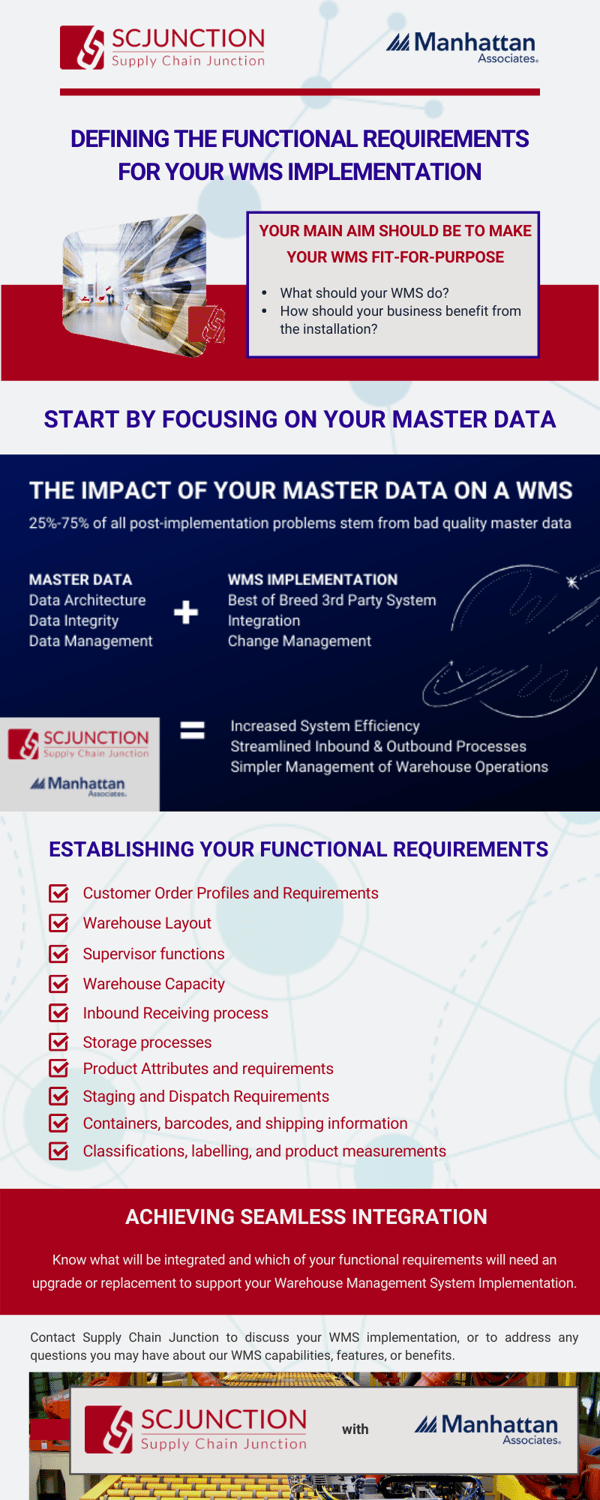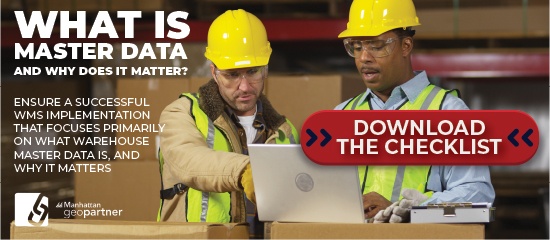Defining the functional requirements for a WMS implementation


Implementing a WMS is a step toward efficiency, productivity, and quality, and to get the best of these benefits, it’s critical to know the functional requirements of your WMS before you purchase and then begin the design and implementation.
Supply Chain Junction provides Manhattan Associates WMS software, implementations and support in South Africa, Saudi Arabia, Kuwait and the United Arab Emirates, and based on our experience, we will present in this blog the information that is critical to your Warehouse Management System’s success.
What makes your WMS fit-for-purpose?
Ensuring your Warehouse Management System supports your business comes down to the nuts and bolts of your customer requirements, order profiles, industry, product, warehouse processes, and business objectives.
Start at the beginning for both your WMS selection and your business requirements:
What should the WMS do?
In each industry, in each distribution centre, the functions of a WMS are fairly similar. Which of these functions has a particularly complicated process in your industry? Where is your warehouse most in need of support?
These answers will change drastically based on the in-depth requirements listed in our next section – and they will inform the WMS implementation team’s handling of the more intricate details of your design.
How should your business benefit from the implementation?
A WMS should help to drive your business objectives through its role as a support and execution tool, enabling you to improve your performance in certain key areas.
What are your warehouse KPIs now and going forward? How will your WMS implementation support these points, and what do you need to ensure is incorporated to facilitate the support?
Our infographic gives you a summary of the required steps to ensure that you have established and outlined your functional requirements before you begin. Get the overview, and then read further for the broader details.

Begin with your Master Data
The quality and accuracy of your master data will have a massive impact on the performance of your Warehouse Management System. With poor quality data, the processes that you are facilitating with a WMS will still result in errors – but at a higher speed.
Avoid this outcome by assessing and improving the fidelity of your Warehouse Master Data and ensuring that you have the information that you need to create a useful, efficient system.
Find out more about master data management from Supply Chain Junction.
What are the functional requirements of your warehouse management system?
Your functional requirements are informed by your warehouse layout, processes, and data. Below are the most critical elements that need to be listed, captured, and cataloged for a successful WMS implementation:
Customer Order Profiles and Requirements
Understanding your customers' requirements and ensuring you configure your Warehouse Management System to meet and exceed these is critical to success
Warehouse Layout
Your warehouse layout, accessibility, and flow impact the setup and programming of your Warehouse Management System.
Warehouse capacity
Your warehouse capacity will be logged, input, and referenced for storage, inbound, and outbound delivery tracking, and cataloging of your product. Know exactly what you’re working with.
Inbound receiving process
How does your receiving process work? Your lane design, capacity, and labour structures must be assessed and reviewed for a successful WMS boost on your receiving department.
Storage processes
Your customer order history and SKU data will inform how you should store your goods, for how long, and when they must be removed or disposed of – this information must be accurate and current to reduce your losses due to spoilage, obsolescence, and damage.
Product attributes and requirements
Supporting your storage processes, you’ll need to have a firm handle on what you are distributing or storing at any given time.
With multiple products and brands in your warehouse, you need to have a very clear picture of the goods you hold. Are they fragile? Perishable? Fresh?
Each section of your warehouse will have to be fit for purpose for these particulars, and your WMS will be implemented in a way that enhances your ability to keep track of them.
Staging and dispatch requirements
Examine how your staging and dispatch processes are structured. What is your capacity, how can you improve, and how will you handle the dispatch processes required with business growth or labour changes?
Containers, barcodes, and shipping information
How your product is labelled, cataloged, and slotted will be a focus when implementing your Warehouse Management System.
This instance is where your Master Data will make a huge difference in the planning and implementation – know what you have in your inventory, where it is, and how to access it.
Classifications, labeling, and product measurements
Follow your industry’s best practices to ensure that your products are
classified correctly, labelled clearly, and you know the weight and dimensions of each shipment. This simplifies receiving, storage, and inventory management.
Your Master Data will inform this segment of your WMS implementation
Integration with your existing assets
Your business software – like your ERP – will be integrated into your WMS for better control and effectiveness. Know what software will be integrated, and which of your functional requirements will need a software upgrade or replacement to correctly support your Warehouse Management System Implementation.
Again, these integrated components will help to ensure that your Master Data is accurate, current, and available at all times. Ensure that you discuss these integration possibilities ahead of time for a more strategic approach.
Improve your Master Data to ensure that your WMS satisfies all your functional requirements:
Download the Master Data Checklist
TAGS
- WMS (51)
- Warehouse Best Practice (46)
- Implementing a WMS (29)
- Managing your warehouse (19)
- Omni Channel (18)
- eCommerce (18)
- Blog (16)
- Supply Chain Best Practice (16)
- Customer Journey (9)
- Mid-Level (8)
- Warehouse optimisation (7)
- General Tips (5)
- Industry General (5)
- Information (5)
- Trends (5)
- managing your Supply Chain (5)
- saudi arabia (5)
- Press Release (4)
- smart warehouse (4)
- 3PL (3)
- News (3)
- ERP (2)
- Entry-level (2)
- ROI (2)
- Case Study (1)
- OMS (1)
- Picking (1)
- Solution-Specific (1)
- Transport Management System (1)
Take A Look At The Results Of A Successful WMS Implementation.
See how Tarsus Distribution, in collaboration with SCJ boost overall efficiency by 60%




